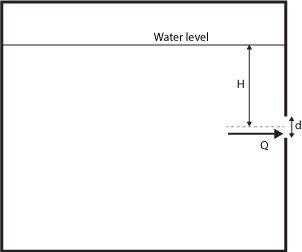Orifice Flow Calculator
The orifice flow calculator estimates the flow rate of liquid discharged from a tank through an orifice. In plain and simple terms, the orifice is a hole or a cutout, using which one can control or restrict the flow rate.
An orifice meter measures and controls the mass flow rate through an orifice for liquids in a tank and is extensively used in fluid mechanics allied applications such as hydraulic equipment, compressors, water tanks, sewage, weirs, and spillways. Orifices are also used to create pressure differentials in a flow.
Read on to understand how this calculator assists you in determining the mass flow through an orifice.
What is an orifice and orifice flow rate?
An orifice is a plate with a hole or cutout attached to the outlet or inserted inside a pipe such that the flow passes through the orifice. The orifice, usually circular, is of known diameter and area to keep the flow regulated. As the fluid flows through an orifice, the pressure drops across the pipe. This phenomenon is also used to measure fluid characteristics.
Mathematically, the orifice flow equation gives the mass flow rate (or discharge) through an orifice, given the area of the orifice, , and can be written as:
where is the coefficient of discharge, is the acceleration due to the specific gravity of Earth (in ), and is the mean center line (the distance between the water level and the center of the orifice).
The coefficient of discharge, , is a function of various parameters such as the diameter of the orifice, , as well as the acceleration due to gravity, the hydraulic depth, and the kinematic viscosity of the fluid, . Mathematically, it can be expressed as:
How to calculate orifice flow rate?
To estimate the orifice flow rate, use the orifice equation discussed above:
-
Insert the diameter of the orifice, .
-
The calculator will now calculate the area of orifice, .
-
Enter the coefficient of discharge, .
-
Enter the value of the mean center line,
-
The acceleration due to gravity, , is already filled in as for your convenience. It can be modified using the
Advanced modeof the calculator. -
The orifice flow calculator will now return the value of discharge or orifice flow rate, .
Example: Using the orifice flow calculator
Determine the flow rate through an orifice that has a diameter of and a mean center line of . Take the coefficient of discharge, as .
To estimate the orifice flow rate:
-
Insert the diameter of the orifice, .
-
The calculator will now estimate the area of the orifice, .
-
Enter the coefficient of discharge, .
-
Enter the value of the mean center line, .
-
The acceleration due to gravity, , is .
-
Using the orifice equation:
FAQ
What is an orifice?
An orifice consists of a flat plate with a cutout that is fixed inside a pipe or at an outlet to create a pressure differential in the fluid flow.
What is orifice flow rate?
The orifice flow rate is defined as the volume of fluid flow through an orifice per unit time. Mathematically, it can be written using the orifice flow equation:
Q = Cd × A × √(2×g×H)
How to calculate mass flow rate through an orifice?
To calculate the flow rate of fluid passing through an orifice:
- Multiply the gravitational constant, g, with the mean centerline, H.
- Multiply the result with 2.
- Find the square root of that product.
- Multiply the resultant with the area of orifice, A, and the coefficient of discharge, Cd.
What are the factors influencing coefficient of discharge?
The coefficient of discharge is a function of variables such as the diameter of the orifice, d; the acceleration due to gravity, g; the hydraulic depth, H; and the kinematic viscosity of the fluid, ν. Mathematically, we can write:
Cd ∝ d × √(gH) / ν
